Traveling to Puerto Rico offers a unique blend of vibrant culture, stunning landscapes, and rich history. At TRAVELS.EDU.VN, we want to ensure your trip is as seamless and enjoyable as possible by providing essential information and insider tips. Whether you’re interested in exploring historical sites, indulging in local cuisine, or relaxing on pristine beaches, understanding these key aspects of Puerto Rico will enhance your experience. Plan your perfect Caribbean vacation with us!
1. Do I Need a Visa or Passport to Travel to Puerto Rico?
For U.S. citizens, no passport or visa is required to enter Puerto Rico, as it is a commonwealth of the United States. However, non-U.S. citizens may need a visa depending on their country of origin.
As a U.S. commonwealth, Puerto Rico operates under U.S. federal laws, making entry straightforward for American citizens. However, there are specific requirements for other nationalities. Here’s what you need to know:
- U.S. Citizens: Since Puerto Rico is a U.S. territory, you don’t need a passport. A valid government-issued photo ID, such as a driver’s license, is sufficient. This makes traveling to Puerto Rico as easy as traveling between states.
- Non-U.S. Citizens: Visa requirements depend on your country of citizenship. If your country participates in the U.S. Visa Waiver Program (VWP), you can enter Puerto Rico without a visa for stays up to 90 days. As of 2024, the VWP includes countries like the United Kingdom, France, Germany, Japan, and Australia. However, you must apply for authorization through the Electronic System for Travel Authorization (ESTA) before your trip. If your country is not part of the VWP, you’ll need to apply for a U.S. visa at a U.S. embassy or consulate in your home country. Ensure you check the latest requirements on the U.S. Department of State’s website.
2. Why Should I Rent a Car for Exploring Puerto Rico?
Renting a car is highly recommended for exploring Puerto Rico beyond the main metropolitan areas due to the limited and unreliable public transportation.
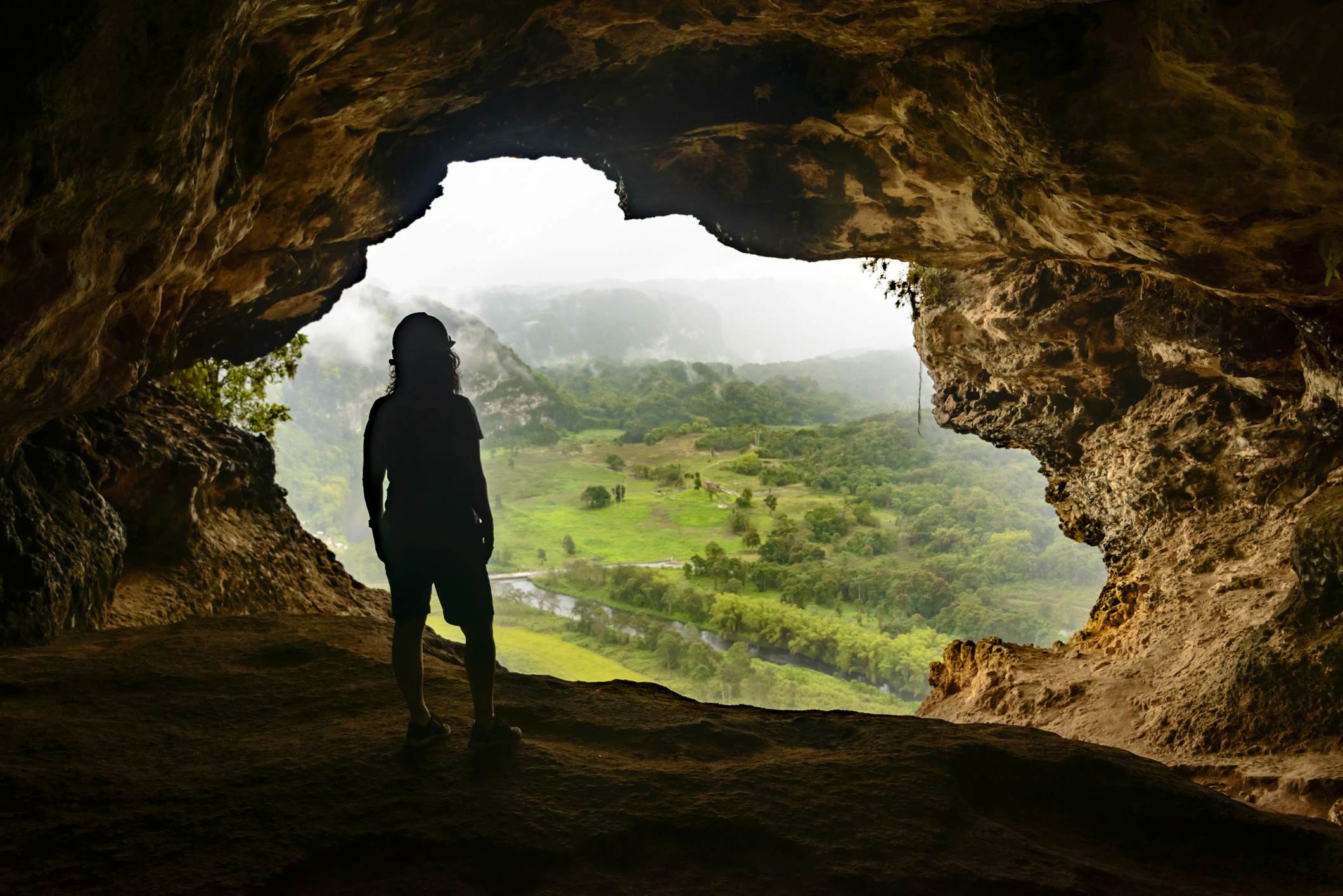 Classic car driving through the historic streets of Old San Juan, Puerto Rico
Classic car driving through the historic streets of Old San Juan, Puerto Rico
While areas like San Juan offer some bus services, venturing into the island’s stunning interior, remote beaches, or historical sites often necessitates having your own vehicle. Here’s why:
- Public Transportation Limitations: The bus system, primarily serving San Juan, Bayamón, and parts of Carolina, is known for its unreliable schedules. This can significantly hinder your ability to explore the island efficiently.
- Access to Scenic Routes: Puerto Rico boasts breathtaking landscapes that are best explored by car. Scenic routes like Expressway 22 and Route 66 offer numerous miradores (lookout points) where you can stop and capture stunning photographs. Without a rental car, these opportunities would be missed.
- Flexibility and Convenience: With a car, you have the freedom to explore at your own pace, making spontaneous stops at local eateries, hidden beaches, and cultural landmarks. This flexibility is invaluable for experiencing the authentic Puerto Rico.
- Cost Considerations: While rental car prices may fluctuate with the season, the overall convenience and access they provide often outweigh the cost. Planning your trip during the off-season can also help you secure better rates.
3. How Long Should I Plan My Trip to Puerto Rico?
To truly experience the diverse offerings of Puerto Rico, plan for at least 7-10 days, allowing you to explore beyond San Juan and immerse yourself in the island’s natural and cultural wonders.
Puerto Rico may be compact, but its varied landscapes and rich cultural heritage offer a plethora of activities and sights. Here’s why a longer trip is beneficial:
- Island Size and Geography: Despite being only 100 miles long and 35 miles wide, Puerto Rico’s diverse geography includes beaches, rainforests, caves, and mountains. Traveling from one side of the island to the other can take up to three hours, so a longer stay reduces travel fatigue.
- Diverse Attractions: From the bioluminescent bays to ancient Taino hieroglyphics in caves, Puerto Rico offers a range of natural wonders. Historical sites, such as Old San Juan, and cultural experiences in smaller towns also require time to explore fully.
- Cultural Immersion: While San Juan offers many tourist attractions, the true Puerto Rican culture is best experienced outside the metropolitan area. Exploring smaller towns and participating in local festivals requires time and a willingness to venture off the beaten path.
- Potential Delays: Construction, road repairs, and traffic jams are common, especially during peak hours (6am-9am and 4pm-7pm). A longer trip allows for these delays without compromising your itinerary.
4. What Type of Clothing Should I Pack for Puerto Rico?
Pack a versatile wardrobe that includes swimwear, casual attire for daytime activities, and dressier outfits for evenings out, ensuring you’re prepared for both the beach and more formal settings.
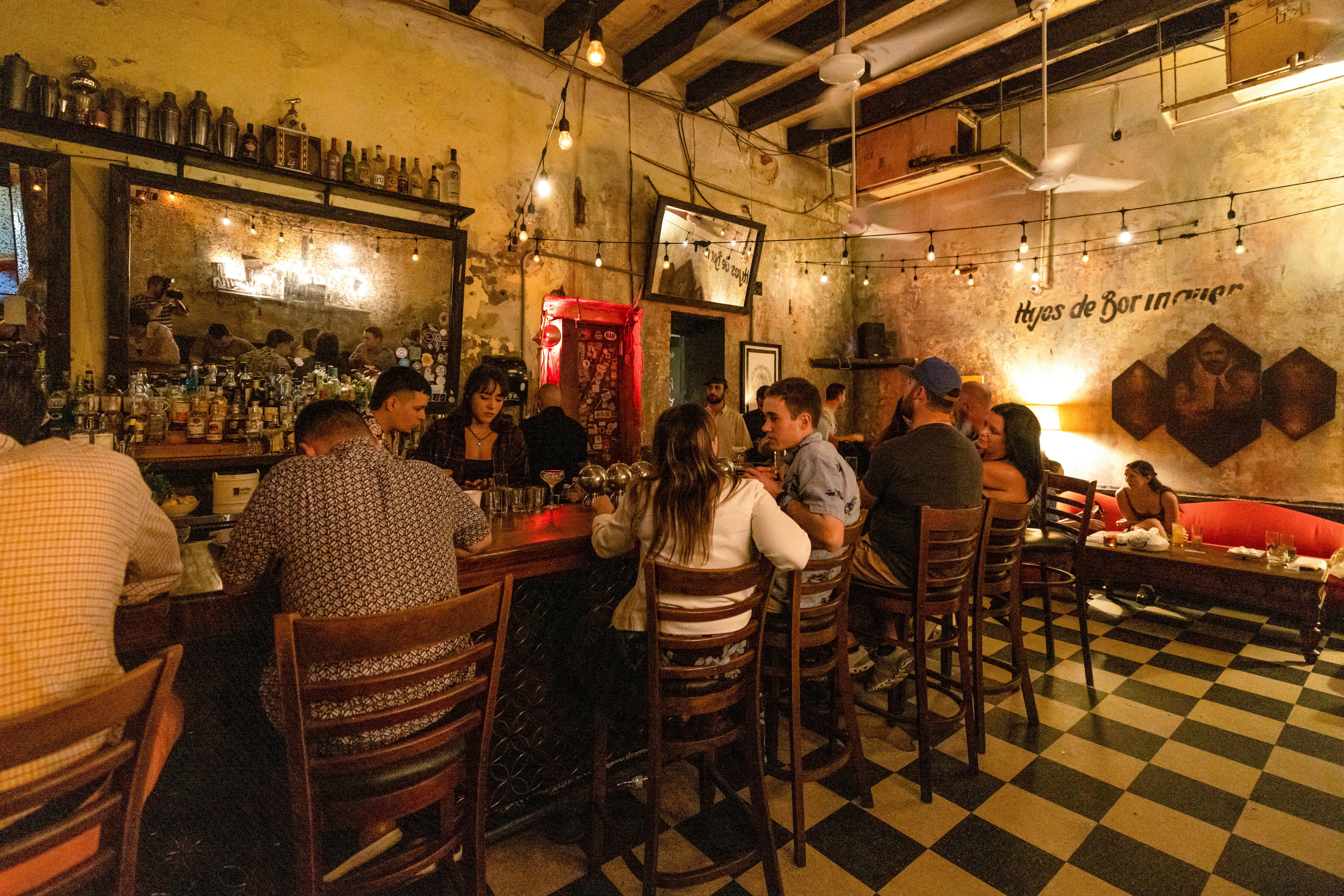 People enjoying cocktails at a stylish bar in Puerto Rico
People enjoying cocktails at a stylish bar in Puerto Rico
Puerto Rico’s culture blends Spanish colonial influences with modern sensibilities, influencing dress codes. Here’s a guide to help you pack appropriately:
- Beach and Casual Wear: Essential items include swimwear, flip-flops, shorts, t-shirts, and sundresses. These are perfect for beach trips, casual restaurants, and exploring outdoor attractions.
- Dressy Outfits: Pack clothing suitable for evenings out, such as smart shoes, dresses, collared shirts, and dress pants. Some clubs and upscale restaurants have dress codes, particularly in metropolitan areas like San Juan.
- Conservative Attire: For visiting religious sites or exploring historical areas like Old San Juan, bring clothes that cover your knees and shoulders. This shows respect for local customs and traditions.
- Practical Items: Don’t forget essentials like sunscreen, hats, and sunglasses to protect yourself from the Caribbean sun. A light jacket or sweater can be useful for cooler evenings or air-conditioned venues.
5. How Far in Advance Should I Buy Tickets for Tours and Attractions?
Booking tickets for tours and attractions in advance is highly recommended, especially during peak season, to ensure availability and avoid disappointment.
Popular activities like snorkeling trips, catamaran tours, and dining at renowned restaurants often have limited capacity. Here’s why advance booking is crucial:
- High Demand: Puerto Rico is a popular tourist destination, and attractions can fill up quickly, especially during peak season (December to April).
- Limited Capacity: Many tours and restaurants have limited seating or capacity, making it essential to book ahead to secure your spot.
- Special Events: If you plan to attend specific events or festivals, booking tickets well in advance is crucial. These events often sell out quickly, especially those that are popular among both locals and tourists.
- Peace of Mind: Booking in advance allows you to relax and enjoy your vacation without worrying about missing out on your desired activities.
6. Is English Widely Spoken in Puerto Rico?
While English is spoken, especially in tourist areas, Spanish is the predominant language in Puerto Rico. Learning basic Spanish phrases will greatly enhance your interactions with locals and your overall experience.
 Man playing accordion in Old San Juan, Puerto Rico
Man playing accordion in Old San Juan, Puerto Rico
Puerto Rico’s linguistic landscape is shaped by its history and cultural identity. Here’s what to expect:
- English Proficiency: In metropolitan areas like San Juan, Caguas, and Carolina, many people, especially those in the tourism industry, speak English fluently.
- Spanish Dominance: Outside the main tourist zones, Spanish is the primary language. Knowing basic Spanish phrases will help you navigate, order food, and engage with locals.
- Courtesy: Even in tourist areas, it’s polite to ask if someone speaks English before initiating a conversation. This shows respect for the local culture.
- Cultural Immersion: Learning and using Spanish can significantly enrich your travel experience, allowing you to connect with Puerto Ricans on a deeper level.
7. How Should I Approach Discussing Politics in Puerto Rico?
Approach political discussions with sensitivity and respect, as the island’s political status is a deeply emotional and controversial topic. Listening and showing genuine interest in Puerto Ricans’ perspectives is key.
Puerto Rico’s political landscape is complex, with ongoing debates about its status as a U.S. territory. Here’s how to navigate these conversations:
- Sensitivity: Be aware that discussions about Puerto Rico’s political status can be highly charged and personal.
- Open Mind: Approach these conversations with an open mind, recognizing that Puerto Rican politics differ significantly from U.S. politics.
- Listening: The best way to understand the local perspective is to listen to Puerto Ricans’ stories and hopes for the island’s future.
- Respect: Avoid imposing your views or making assumptions. Show respect for the diverse opinions and experiences of the people you meet.
8. What Kind of Cuisine Can I Expect in Puerto Rico?
Puerto Rican cuisine is diverse and flavorful, blending influences from West Africa, Spain, and Asia. Be prepared to explore beyond the popular street snacks and discover the island’s rich culinary landscape.
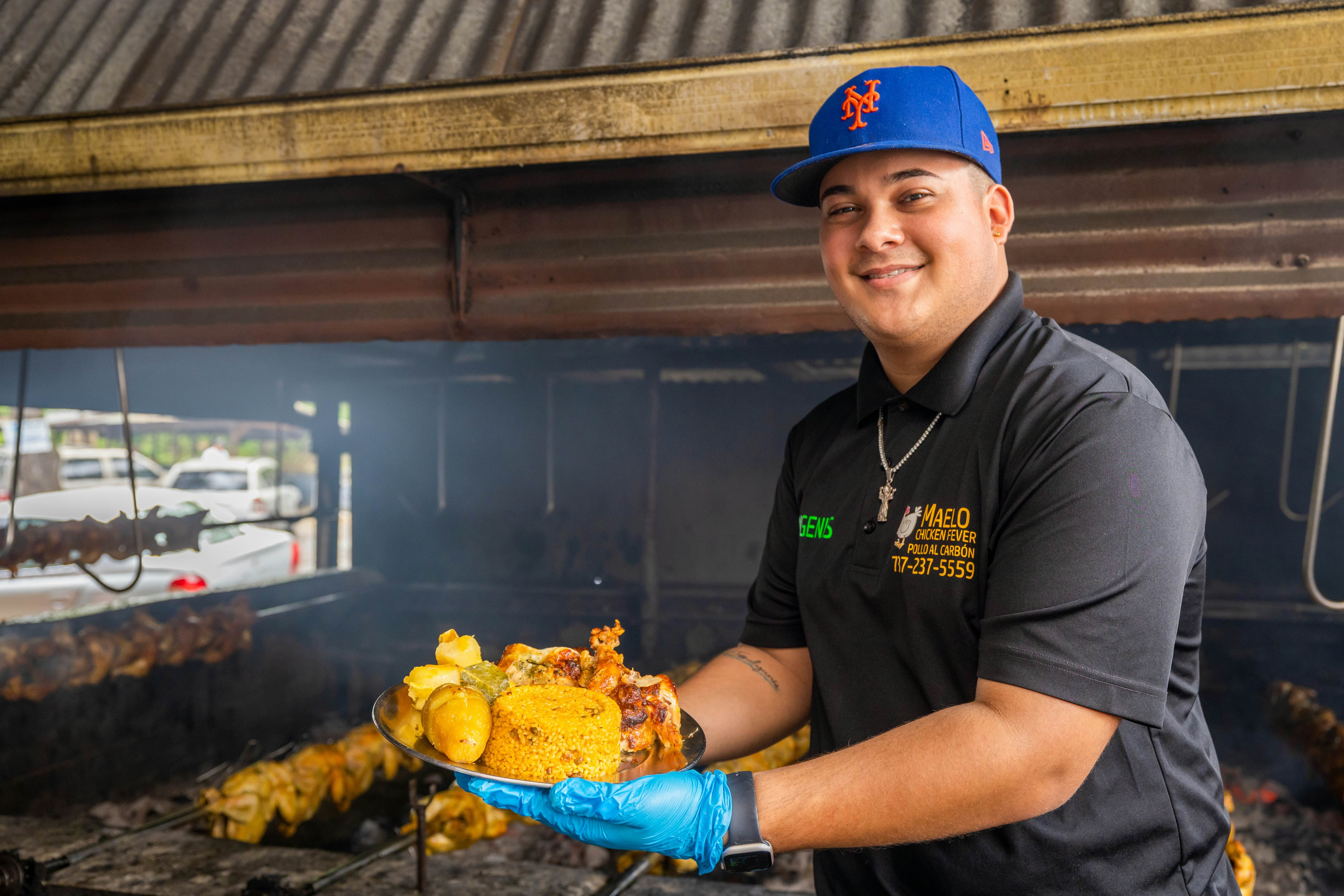 Man holding a plate of delicious Puerto Rican food
Man holding a plate of delicious Puerto Rican food
From traditional dishes to innovative culinary creations, Puerto Rico offers a wide array of dining experiences. Here’s a taste of what you can expect:
- Traditional Snacks: Enjoy popular street foods like pernil (roast pork), alcapurrias (stuffed, fried fritters), and bacalaitos (codfish fritters).
- Diverse Influences: Puerto Rican cuisine is a fusion of flavors from West Africa, Spain, and Asia, creating unique and complex dishes.
- Vegetarian Options: Vegetarian-friendly restaurants like El Grifo in Caguas and 100% HP in San Juan offer plant-based alternatives to traditional dishes.
- Fine Dining: Experience world-class cuisine at restaurants like 1919 Restaurant in the Vanderbilt Hotel, offering elegant and innovative dishes.
- Local Favorites: Don’t miss out on trying mofongo (mashed fried plantains) and pernil, but also explore the many Puerto Rican-Chinese restaurants, known for their cozy, family-run atmosphere.
9. What is “Island Time” Like in Puerto Rico?
“Island time” in Puerto Rico means embracing a more relaxed and unhurried pace. Be prepared for potential delays and long lines, and adopt a patient and easygoing attitude.
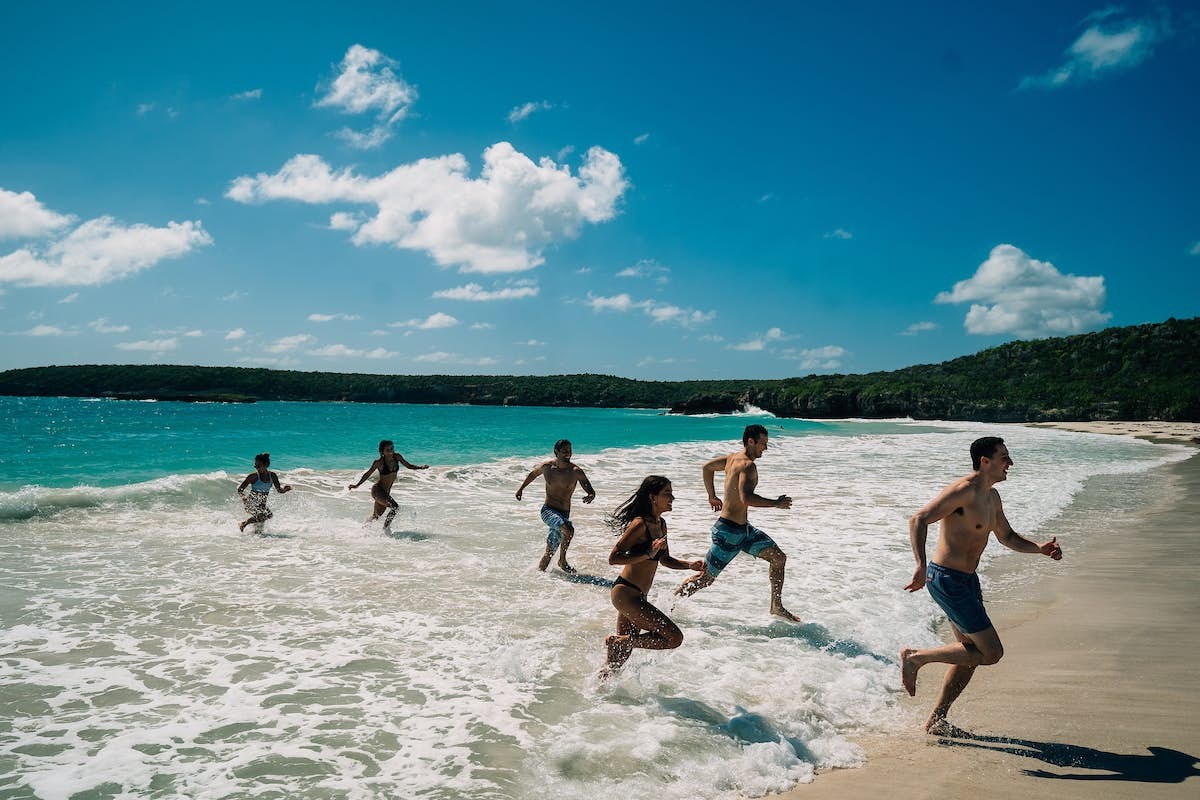 Family running out of the sea at a beautiful beach in Vieques, Puerto Rico
Family running out of the sea at a beautiful beach in Vieques, Puerto Rico
While Puerto Rico has a bustling metropolitan center, life often moves at a slower pace. Here’s how to adjust:
- Relaxed Pace: Embrace the laid-back atmosphere and avoid rushing or becoming impatient.
- Potential Delays: Be prepared for long lines at government offices, restaurants, and supermarkets.
- Patience: Avoid making a scene or showing frustration if service takes longer than expected.
- Small Talk: Engage in friendly conversation and enjoy the art of Puerto Rican small talk while you wait.
10. What Should I Know About Hurricane Season in Puerto Rico?
Be aware that hurricane season in the Caribbean runs from June 1 to November 30. While Puerto Rico isn’t always hit, it’s essential to stay informed and prepared.
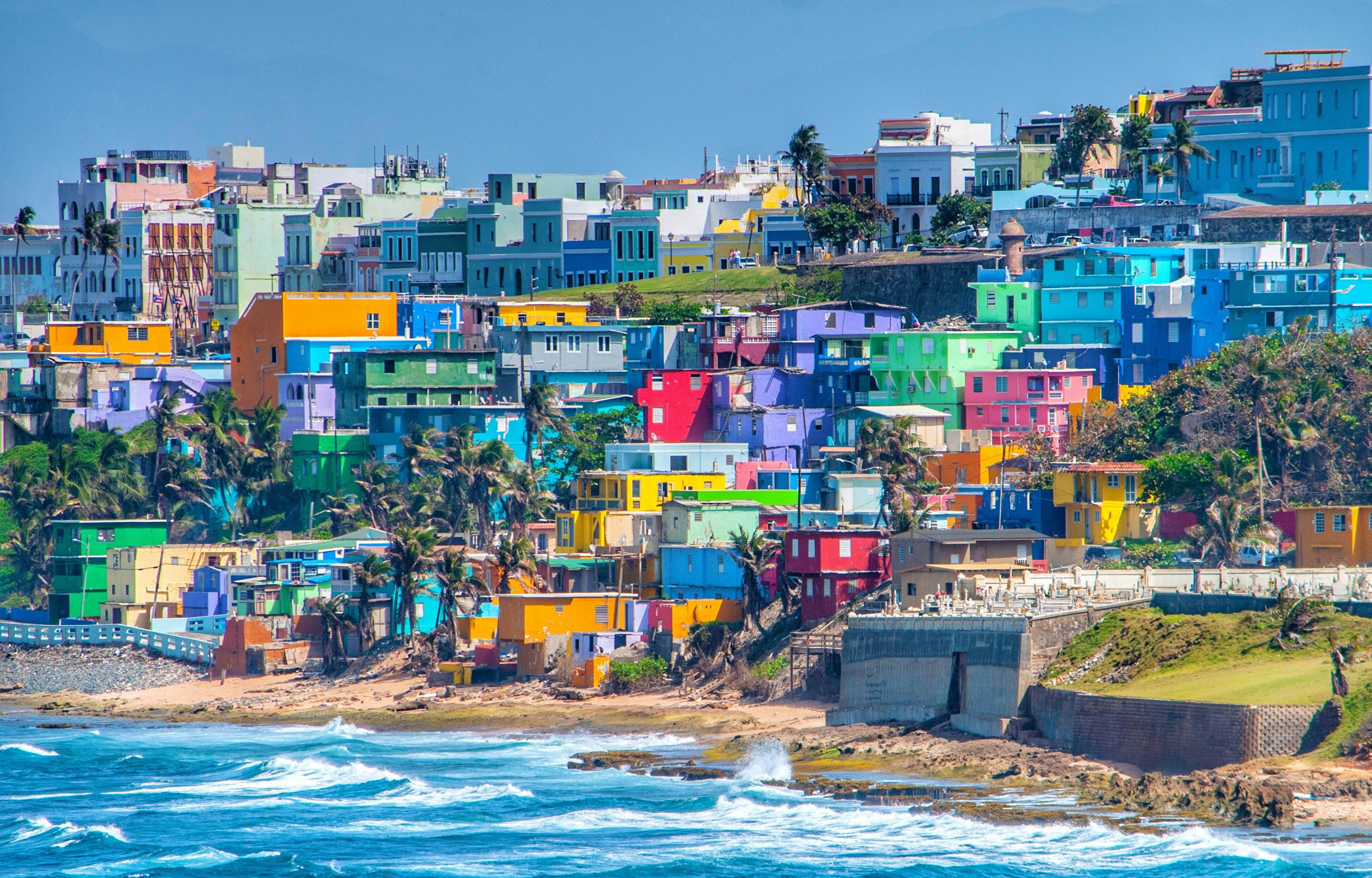 Colourful buildings by the sea in San Juan, Puerto Rico
Colourful buildings by the sea in San Juan, Puerto Rico
Hurricanes can pose a significant risk, so here’s how to plan accordingly:
- Hurricane Season: The official hurricane season in the Caribbean is from June 1 to November 30.
- Travel Policies: When booking hotels and flights during hurricane season, check your airline’s and hotel’s natural disaster policies.
- Emergency Plans: If you get stuck in Puerto Rico during a hurricane, your hotel will likely have an emergency plan. Ask about contingency measures before your trip.
- Monitoring: Keep an eye on the news and weather apps for warnings of approaching storms.
- Travel Flexibility: Consider purchasing travel insurance that covers cancellations and interruptions due to hurricanes.
11. How Can I Stay Safe on Puerto Rico’s Beaches?
Exercise caution on Puerto Rico’s beaches, as lifeguards are not always present. Be aware of rip currents, avoid swimming alone, and protect your belongings from theft.
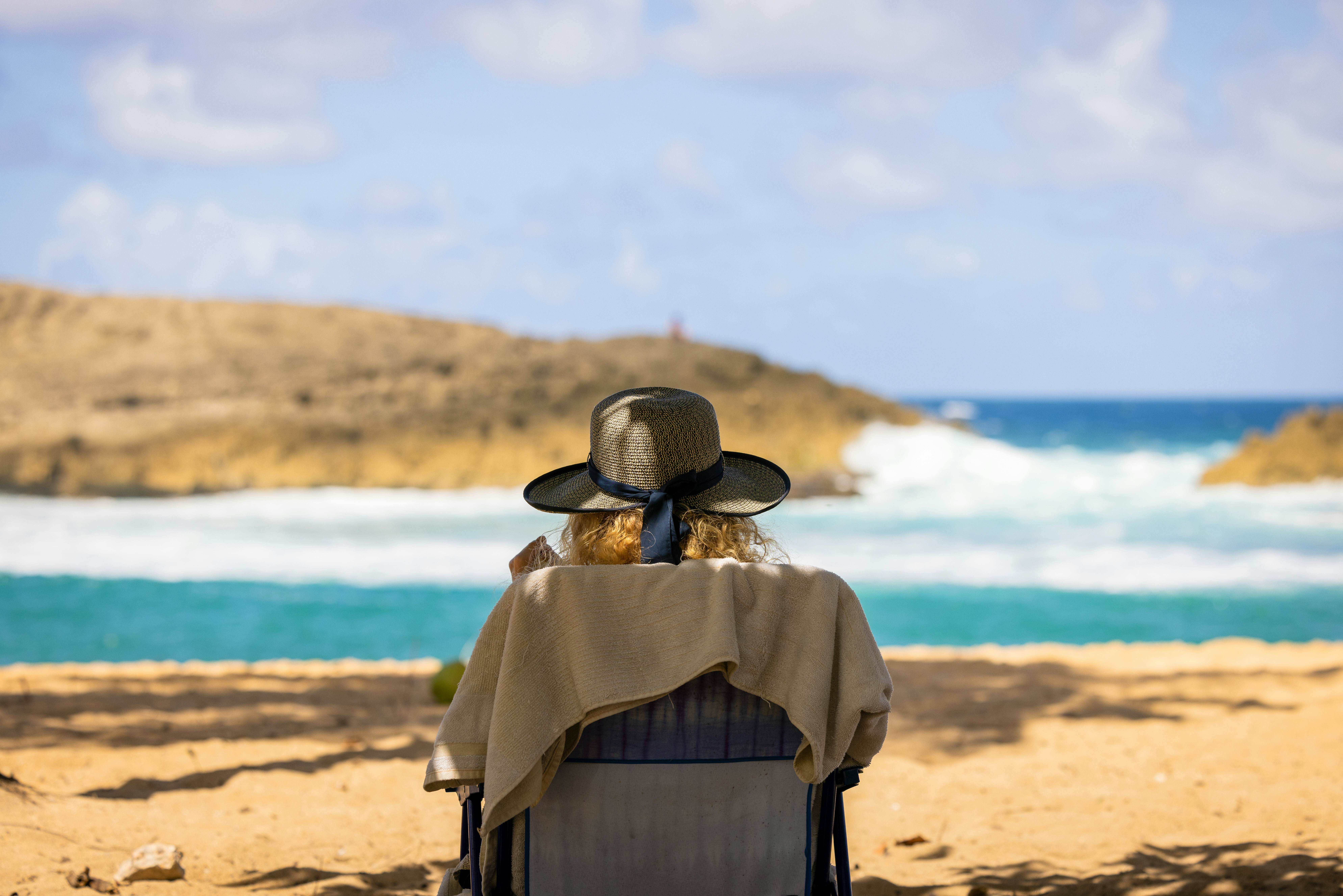 Back view of a woman sat in a chair on the beach, in the shade, with a sun hat on
Back view of a woman sat in a chair on the beach, in the shade, with a sun hat on
Puerto Rico’s beaches are beautiful but require caution. Here’s how to stay safe:
- Lifeguards: Be aware that many beaches do not have lifeguards on duty.
- Ocean Conditions: The Atlantic coast in the north tends to have choppier waters than the Caribbean coast in the south.
- Rip Currents: Learn to spot rip currents by looking for differences in the water’s surface. If caught in one, swim parallel to the shore until you escape the current.
- Swimming with Children: Exercise extra caution when swimming with children.
- Empty Beaches: If a beach or area of water is completely empty, there may be a reason, such as jellyfish or strong undercurrents.
- Personal Belongings: Avoid bringing expensive jewelry or cameras to the beach, and never leave purses unattended.
12. How Can I Stay Safe in Urban Areas of Puerto Rico?
Exercise the same caution you would in any major city. Be aware of your surroundings, avoid dark and empty streets, and research the safety levels of the area where you’re staying.
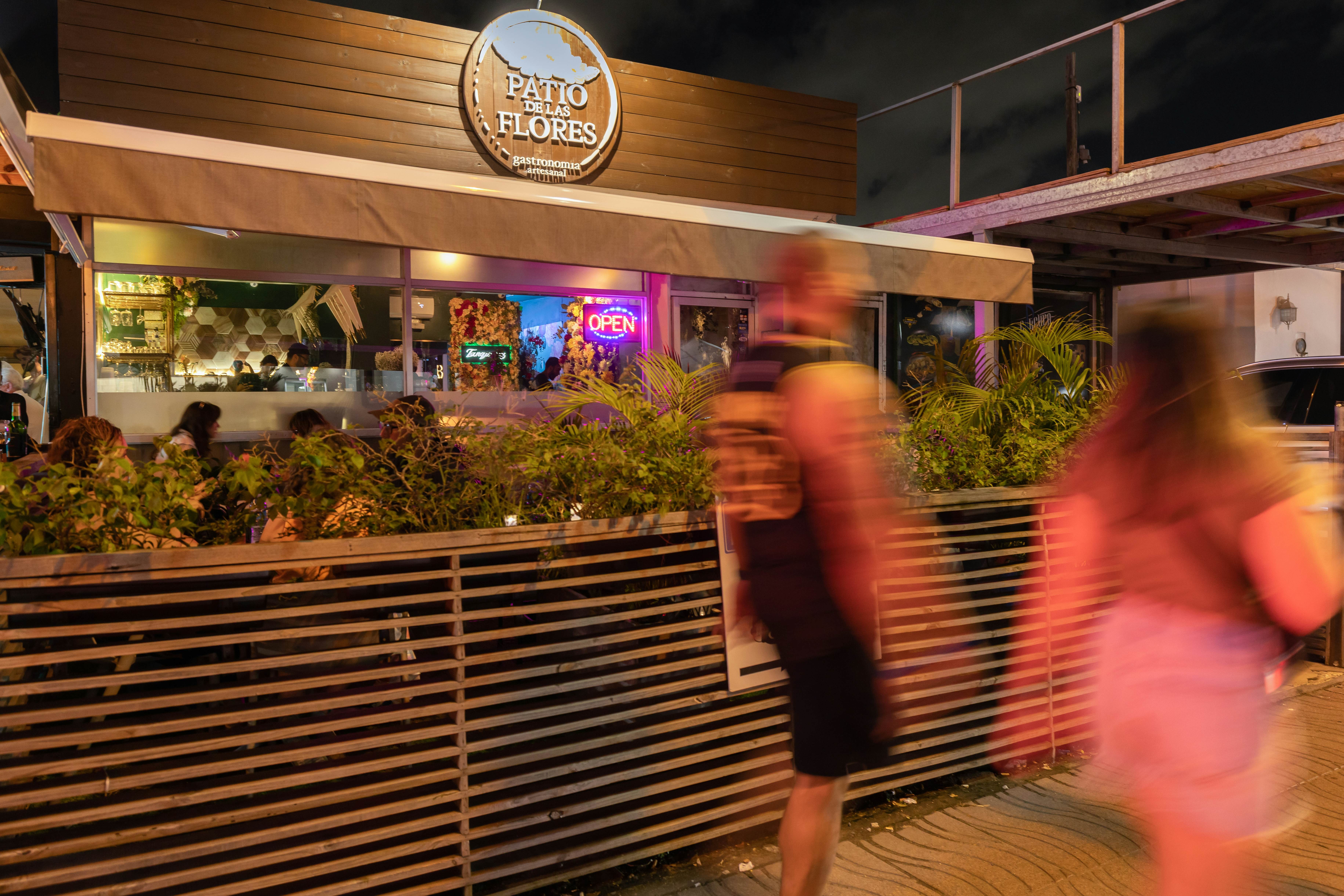 Blurred people walk past the exterior of a cocktail bar in San Juan, Puerto Rico
Blurred people walk past the exterior of a cocktail bar in San Juan, Puerto Rico
While Puerto Rico is generally safe, it’s important to take precautions, especially in urban areas:
- Awareness: Be aware of your surroundings, especially at night.
- Avoidance: Avoid dark, empty streets in Old San Juan and other San Juan neighborhoods.
- High-Crime Areas: Exercise caution when venturing out to clubs in Santurce, which is known to be a high-crime area at night.
- Beach Safety: Some beaches in urban areas are not safe at night due to lack of lighting and police presence.
- Research: Research the area where you’re staying and speak to locals or previous visitors to gauge safety levels.
13. What Health Precautions Should I Take in Puerto Rico?
Protect yourself from the sun and bugs by using plenty of sunblock and DEET-based bug spray, especially in areas near standing water.
The Caribbean climate presents unique health challenges. Here’s how to stay healthy:
- Sun Protection: The Caribbean sun can be intense, especially between noon and 4pm. Use SPF50 or higher sunblock to avoid sunburn.
- Bug Spray: Mosquitoes can be a nuisance and can carry diseases like dengue fever, Zika, and chikungunya. Use DEET-based bug spray, especially near standing water like mangroves and lagoons.
- Hydration: Drink plenty of water to stay hydrated in the tropical climate.
- Health Insurance: Check if your health insurance covers medical expenses in Puerto Rico, or consider purchasing travel insurance.
Plan Your Puerto Rican Getaway with TRAVELS.EDU.VN
Ready to experience the beauty and culture of Puerto Rico? Let TRAVELS.EDU.VN help you plan your dream vacation. We offer personalized travel packages that cater to your interests and budget, ensuring a seamless and unforgettable experience.
Why Choose TRAVELS.EDU.VN?
- Expertise: Our team of travel experts has extensive knowledge of Puerto Rico, providing you with insider tips and recommendations.
- Customization: We tailor our travel packages to your specific needs and preferences, ensuring a unique and personalized experience.
- Convenience: From booking flights and accommodations to arranging tours and activities, we handle all the details, so you can relax and enjoy your vacation.
- Support: We provide ongoing support throughout your trip, ensuring any issues are resolved quickly and efficiently.
Our Services Include:
- Personalized Itineraries: We create customized itineraries based on your interests, whether you’re interested in history, nature, cuisine, or relaxation.
- Accommodation Booking: We offer a wide range of accommodation options, from luxury resorts to boutique hotels, ensuring you find the perfect place to stay.
- Tour and Activity Arrangements: We arrange tours and activities, including snorkeling trips, historical tours, and culinary experiences.
- Transportation: We handle transportation logistics, including airport transfers and rental car arrangements.
Contact Us Today
Don’t wait any longer to plan your Puerto Rican adventure. Contact TRAVELS.EDU.VN today and let us help you create the perfect vacation.
Address: 123 Main St, Napa, CA 94559, United States
WhatsApp: +1 (707) 257-5400
Website: TRAVELS.EDU.VN
Let travels.edu.vn be your guide to an unforgettable journey in Puerto Rico. Book your trip now and discover the magic of this Caribbean paradise.
Frequently Asked Questions About Traveling to Puerto Rico
1. What is the best time of year to visit Puerto Rico?
The best time to visit Puerto Rico is from mid-April to June, after the busy winter season and before the hurricane season. The weather is pleasant, and prices for accommodations and activities are generally lower.
2. Can I use US dollars in Puerto Rico?
Yes, the official currency of Puerto Rico is the US dollar (USD). Credit cards are widely accepted, but it’s a good idea to carry some cash for smaller establishments and local markets.
3. What are the top attractions to visit in Puerto Rico?
Top attractions include Old San Juan, El Yunque National Forest, the bioluminescent bays (Vieques, Fajardo, and Lajas), and the beaches of Isla Verde and Condado.
4. Is it safe to drink tap water in Puerto Rico?
While tap water in Puerto Rico is generally considered safe to drink, many visitors prefer to drink bottled water to avoid any potential issues.
5. What type of electrical outlets are used in Puerto Rico?
Puerto Rico uses the same type of electrical outlets as the United States (Type A and Type B), with a standard voltage of 120 V and a frequency of 60 Hz.
6. What should I do in case of a medical emergency in Puerto Rico?
In case of a medical emergency, dial 911 for assistance. Puerto Rico has modern hospitals and medical facilities, particularly in metropolitan areas.
7. Are there any cultural etiquette tips I should be aware of?
Respectful behavior and politeness are appreciated. Dress modestly when visiting religious sites and greet people with a friendly “Hola” or “Buenos días.”
8. What are some popular local dishes I should try in Puerto Rico?
Popular local dishes include mofongo (mashed fried plantains), lechón asado (roasted pork), arroz con gandules (rice with pigeon peas), and tostones (fried green plantains).
9. How can I get around in San Juan without a car?
In San Juan, you can use taxis, Uber, or the local bus system (AMA) to get around. Walking is also a great option for exploring Old San Juan.
10. What are some good souvenirs to buy in Puerto Rico?
Good souvenirs to buy in Puerto Rico include locally made crafts, coffee, rum, hot sauce, and traditional musical instruments like the güiro.